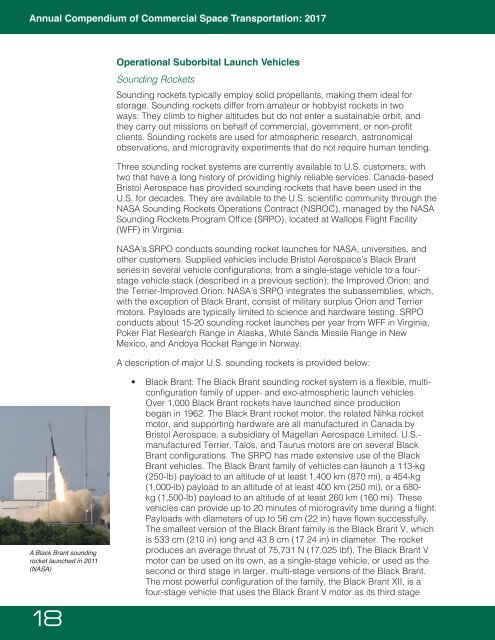The Annual Compendium of Commercial Space Transportation 2017
2nuZwBH
2nuZwBH
Create successful ePaper yourself
Turn your PDF publications into a flip-book with our unique Google optimized e-Paper software.
<strong>Annual</strong> <strong>Compendium</strong> <strong>of</strong> <strong>Commercial</strong> <strong>Space</strong> <strong>Transportation</strong>: <strong>2017</strong><br />
Operational Suborbital Launch Vehicles<br />
Sounding Rockets<br />
Sounding rockets typically employ solid propellants, making them ideal for<br />
storage. Sounding rockets differ from amateur or hobbyist rockets in two<br />
ways: <strong>The</strong>y climb to higher altitudes but do not enter a sustainable orbit, and<br />
they carry out missions on behalf <strong>of</strong> commercial, government, or non-pr<strong>of</strong>it<br />
clients. Sounding rockets are used for atmospheric research, astronomical<br />
observations, and microgravity experiments that do not require human tending.<br />
Three sounding rocket systems are currently available to U.S. customers, with<br />
two that have a long history <strong>of</strong> providing highly reliable services. Canada-based<br />
Bristol Aerospace has provided sounding rockets that have been used in the<br />
U.S. for decades. <strong>The</strong>y are available to the U.S. scientific community through the<br />
NASA Sounding Rockets Operations Contract (NSROC), managed by the NASA<br />
Sounding Rockets Program Office (SRPO), located at Wallops Flight Facility<br />
(WFF) in Virginia.<br />
NASA’s SRPO conducts sounding rocket launches for NASA, universities, and<br />
other customers. Supplied vehicles include Bristol Aerospace’s Black Brant<br />
series in several vehicle configurations, from a single-stage vehicle to a fourstage<br />
vehicle stack (described in a previous section); the Improved Orion; and<br />
the Terrier-Improved Orion. NASA’s SRPO integrates the subassemblies, which,<br />
with the exception <strong>of</strong> Black Brant, consist <strong>of</strong> military surplus Orion and Terrier<br />
motors. Payloads are typically limited to science and hardware testing. SRPO<br />
conducts about 15-20 sounding rocket launches per year from WFF in Virginia,<br />
Poker Flat Research Range in Alaska, White Sands Missile Range in New<br />
Mexico, and Andoya Rocket Range in Norway.<br />
A description <strong>of</strong> major U.S. sounding rockets is provided below:<br />
A Black Brant sounding<br />
rocket launched in 2011<br />
(NASA)<br />
18<br />
••<br />
Black Brant: <strong>The</strong> Black Brant sounding rocket system is a flexible, multiconfiguration<br />
family <strong>of</strong> upper- and exo-atmospheric launch vehicles.<br />
Over 1,000 Black Brant rockets have launched since production<br />
began in 1962. <strong>The</strong> Black Brant rocket motor, the related Nihka rocket<br />
motor, and supporting hardware are all manufactured in Canada by<br />
Bristol Aerospace, a subsidiary <strong>of</strong> Magellan Aerospace Limited. U.S.-<br />
manufactured Terrier, Talos, and Taurus motors are on several Black<br />
Brant configurations. <strong>The</strong> SRPO has made extensive use <strong>of</strong> the Black<br />
Brant vehicles. <strong>The</strong> Black Brant family <strong>of</strong> vehicles can launch a 113-kg<br />
(250-lb) payload to an altitude <strong>of</strong> at least 1,400 km (870 mi), a 454-kg<br />
(1,000-lb) payload to an altitude <strong>of</strong> at least 400 km (250 mi), or a 680-<br />
kg (1,500-lb) payload to an altitude <strong>of</strong> at least 260 km (160 mi). <strong>The</strong>se<br />
vehicles can provide up to 20 minutes <strong>of</strong> microgravity time during a flight.<br />
Payloads with diameters <strong>of</strong> up to 56 cm (22 in) have flown successfully.<br />
<strong>The</strong> smallest version <strong>of</strong> the Black Brant family is the Black Brant V, which<br />
is 533 cm (210 in) long and 43.8 cm (17.24 in) in diameter. <strong>The</strong> rocket<br />
produces an average thrust <strong>of</strong> 75,731 N (17,025 lbf). <strong>The</strong> Black Brant V<br />
motor can be used on its own, as a single-stage vehicle, or used as the<br />
second or third stage in larger, multi-stage versions <strong>of</strong> the Black Brant.<br />
<strong>The</strong> most powerful configuration <strong>of</strong> the family, the Black Brant XII, is a<br />
four-stage vehicle that uses the Black Brant V motor as its third stage


